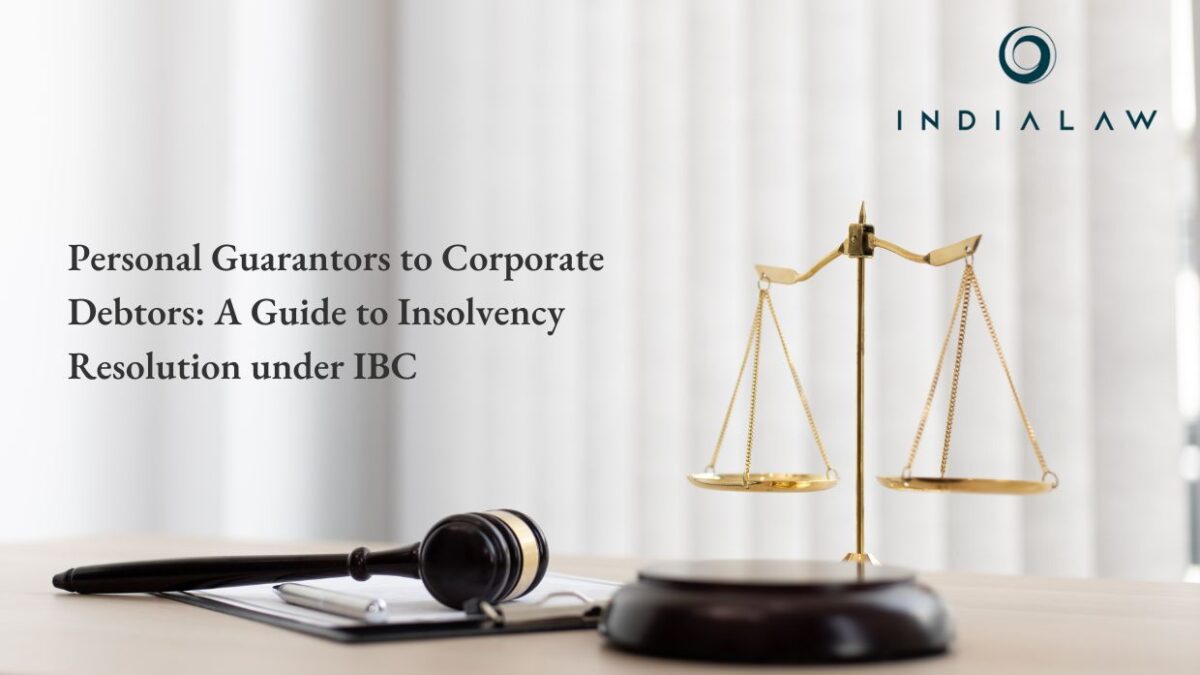Personal Guarantors to Corporate Debtors: A Guide to Insolvency Resolution under IBC


Introduction
The Insolvency and Bankruptcy Code (IBC), 2016, provides a robust legal framework to resolve insolvency and ensure the timely reorganization of debts. Sections 94 to 120, specifically, deal with the insolvency resolution process for individuals, firms and personal guarantors to corporate debtors. However, as per the Central Government notification dated 15th November 2019, these provisions have currently been made applicable only to personal guarantors to corporate debtors and not to other individuals or partnership firms. The notification further specifies that all applications under Sections 94 and 95 must be filed before the National Company Law Tribunal (NCLT) instead of the Debt Recovery Tribunal (DRT). This change ensures alignment between the insolvency process for corporate debtors and their personal guarantors, creating a unified resolution framework.
Table of Contents
Detailed Overview of Sections 94–120
Section 94: Application by Debtors
A personal guarantor can initiate the insolvency resolution process by submitting an application to the NCLT. The application must provide a statement of affairs, include details of the debt owed, and comply with prescribed forms. The debtor cannot file such an application if they are an undischarged bankrupt or involved in an ongoing insolvency or bankruptcy process.
Section 95: Application by Creditors
Creditors, including secured and unsecured creditors, can apply for insolvency resolution against the personal guarantor. The application must specify:
- The debt amount and proof of default.
- Whether the creditor relinquishes security (in case of secured creditors).
The creditor may file the application through a resolution professional.
Section 96: Interim-Moratorium
Once an application under Section 94 or 95 is filed:
- An interim-moratorium begins immediately, halting all recovery proceedings against the personal guarantor’s property.
- Creditors are barred from initiating or continuing legal actions during this period.
Sections 97–99: Resolution Professional’s Role
- The NCLT appoints a resolution professional within 7 days of receiving the application.
- The resolution professional examines the financial position of the personal guarantor, collects evidence, and submits a report within 10 days recommending acceptance or rejection of the application.
Section 100: Admission or Rejection of Application
Based on the resolution professional’s report, the NCLT decides whether to admit or reject the application within 14 days. If rejected, the tribunal must record its reasons.
Section 101: Moratorium
Upon admitting the application, a moratorium begins, lasting for 180 days or until a repayment plan is approved. During the moratorium:
- Legal proceedings and recovery actions are prohibited.
- Creditors cannot enforce claims against the personal guarantor’s property.
Sections 102–106: Creditor Claims and Meetings
- Public notice is issued inviting creditors to submit claims.
- The resolution professional compiles a list of creditors and convenes a meeting to discuss the proposed repayment plan.
Sections 107–110: Repayment Plan Approval
- Creditors review, modify, and approve the repayment plan through a voting process.
- The approved plan is submitted to the NCLT for confirmation.
- Once confirmed, the plan becomes binding on all creditors and the personal guarantor.
Sections 111–118: Implementation of the Repayment Plan
- The resolution professional oversees the implementation of the repayment plan.
- If the personal guarantor defaults on the plan, the creditors can file for a bankruptcy order against them.
Section 119: Discharge Order
After successful implementation of the repayment plan, the NCLT issues a discharge order, releasing the personal guarantor from all debts covered under the plan. However, this does not affect the liability of other parties, such as co-guarantors or corporate debtors.
Section 120: Code of Conduct for Resolution Professionals
Resolution professionals are required to adhere to a strict code of conduct as prescribed under Section 208 of the IBC, ensuring impartiality, transparency, and efficiency.
Conclusion
Sections 94 to 120 of the IBC, 2016, provide a comprehensive framework for resolving the insolvency of personal guarantors to corporate debtors, ensuring greater accountability and alignment with the corporate insolvency process. The notification of 15th November 2019 marks a significant reform by empowering the NCLT as the adjudicating authority for such cases. This integration streamlines the resolution process, enabling a coordinated approach to address the financial distress of corporate debtors and their guarantors. By introducing provisions like moratoriums, structured creditor meetings, and repayment plans, the Code balances the rights of creditors with the opportunity for debtors to restructure and resolve their financial obligations. Overall, this framework fosters efficiency, transparency, and fairness, further strengthening India’s insolvency ecosystem.
For further details write to contact@indialaw.in




